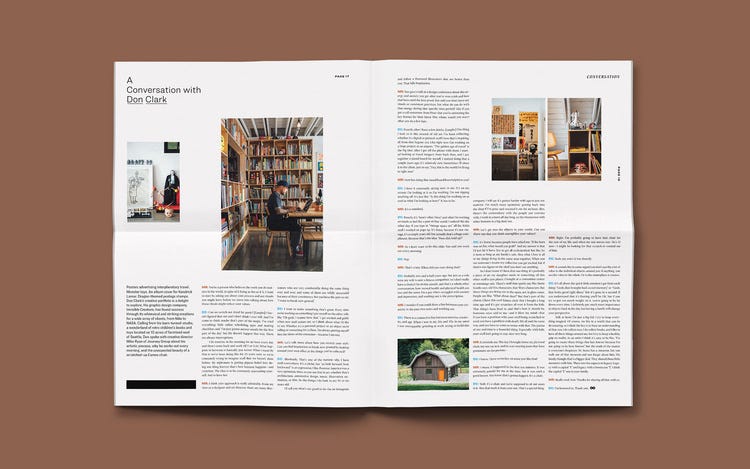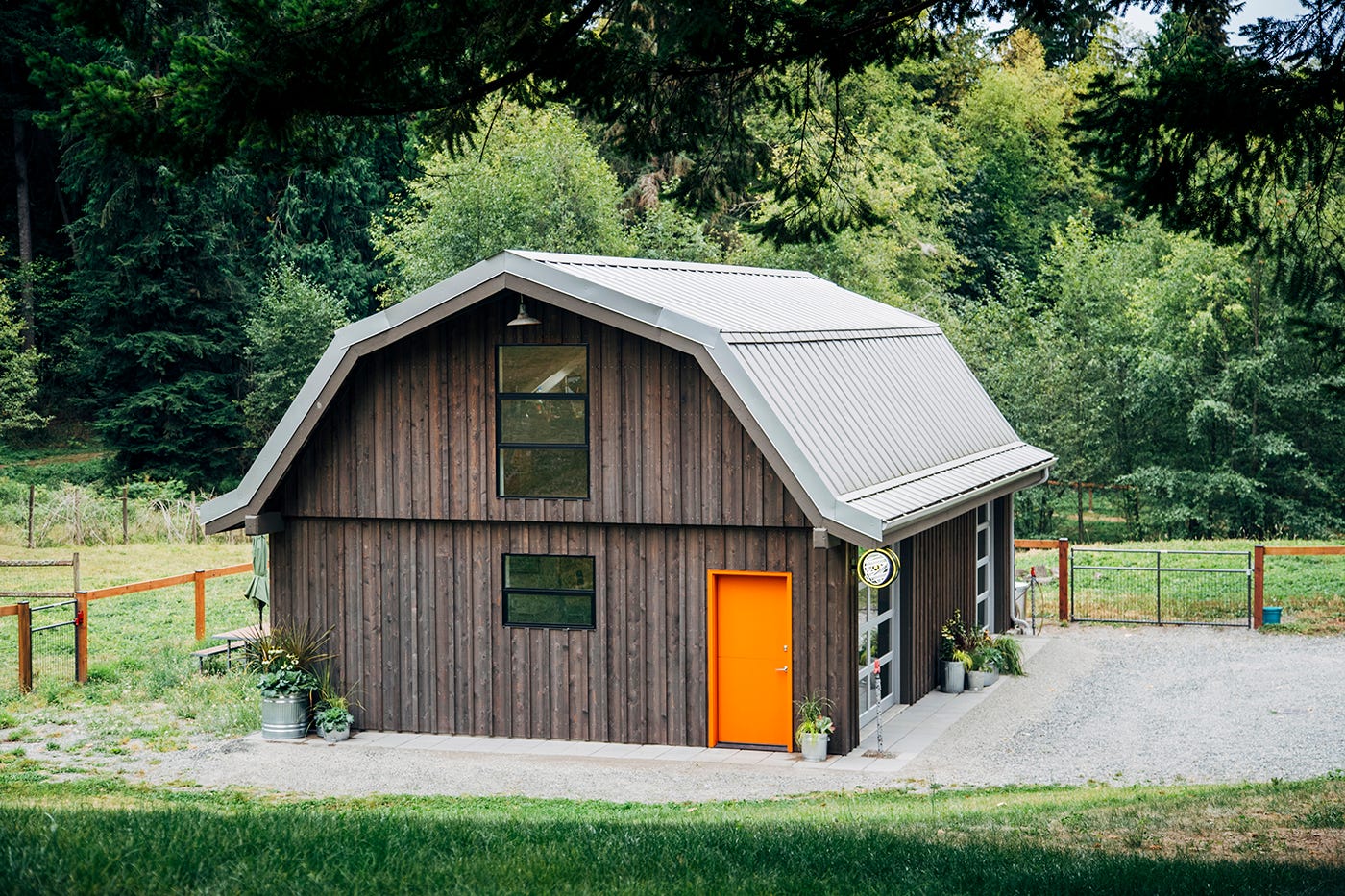Posters advertising interplanetary travel. Monster toys. An album cover for Kendrick Lamar. Don Clark’s creative portfolio is a delight to explore. His graphic design company, Invisible Creature, has found success through its whimsical and striking creations for a wide array of clients, from Nike to NASA. With Journey Group, I had the opportunity to collaborate with Don on Dragon-themed postage stamps and children’s book.
Calling from his barn-turned-studio, a wonderland of retro children’s books and toys located on 10 acres of farmland east of Seattle, Clark spoke with me, creative director of Journey Group, about his artistic process, why he works out every morning, and the unexpected beauty of a scratched-up Eames chair.
MR: You’re a person who believes the work you do matters in the world, in spite of it being as fun as it is. I want to start by asking you about your process and any rituals you might have, before we move into talking about how those rituals might reflect your values.
DC: Can we switch out ritual for panic? [Laughs] I haven’t figured that out and I don’t think I ever will. And I’ve come to think maybe that’s part of the magic. I’ve tried everything: little online scheduling apps and making checklists and “I’m just gonna answer emails for the first part of the day,” but life doesn’t happen that way. There are always interruptions.
I do exercise in the morning for an hour every day, and then I come back and work till 5 or 5:30. What happens in between is basically just terror. What I mean by that is, we’ve been doing this for 20 years now, so we’re constantly trying to imagine stuff that we haven’t done before. My nightmare is getting pigeon-holed into doing one thing forever; that’s how burnout happens — and cynicism. The idea is to be constantly reinventing yourself. And to have fun.
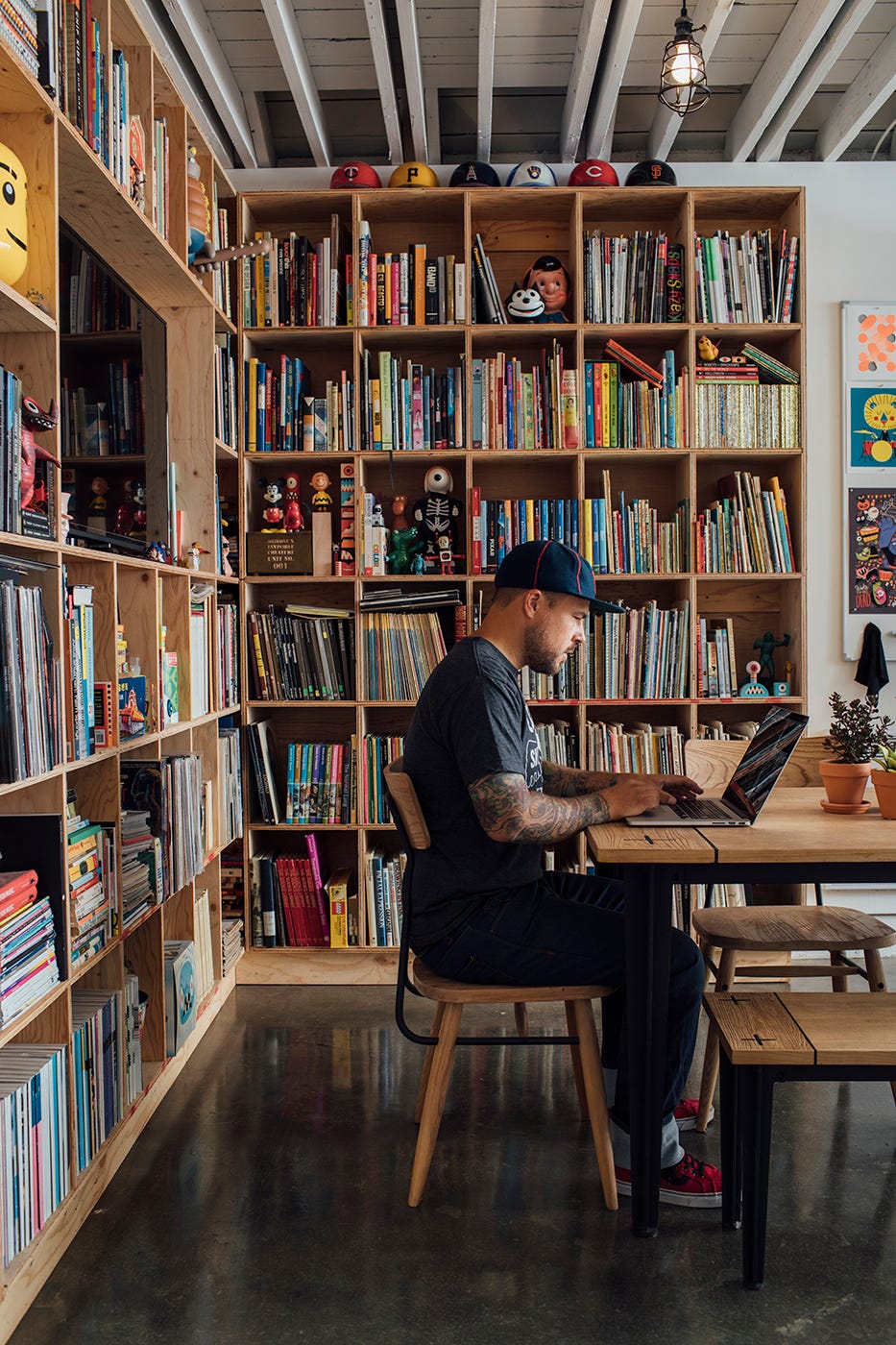
MR: I think your approach is really admirable. From my view as a designer and art director, there are many illustrators who are very comfortable doing the same thing over and over, and some of them are wildly successful because of their consistency. But you have the guts to say, “I want to break new ground.”
DC: I want to make something that’s great. Every time we’re working on something I put myself on the other side, like, “Oh gosh, I wanna have that.” I get excited and giddy when new stuff comes out, so I think about what I’d like to see. Whether it’s a personal project or an object we’re selling or something for a client, I’m always putting myself into the shoes of the consumer, because I am one.
MR: Let’s talk more about how you stretch your style. Can you find inspiration to break new ground by looking around your own office at the things you’ve collected?
DC: Absolutely. That’s one of the reasons why I have stuff everywhere. It’s a cliché, but “to look forward, look backward” is an expression I like. Postwar America was a very optimistic time, so you see that in art, whether that’s architecture, automotive design, music, illustration, animation, or film. So the things I do look to are 50 or 60 years old.
“I’ll tell you what’s not good to do: go on Instagram or social media and follow a thousand illustrators that are better than you. That kills inspiration.”
MR: You gave a talk at a design conference about the energy and anxiety you get after you’ve won a job, and how that lasts until the first proof. You said you don’t have any rituals or consistent practices, but what do you do with that energy during that specific time period? Like if you got a call tomorrow from Pixar that you’re animating the key frames for their latest film, where would you start? After you do a few laps…
DC: Exactly, after I have a few drinks. [Laughs] One thing I look to is this arsenal of old art I’ve been collecting, whether it’s digital or printed: stuff I love that’s inspiring, all from that bygone era. Like right now I’m working on a huge project at an airport. “The golden age of travel” is the big idea. After I got off the phone with them, I started looking at travel imagery from back then, and I put together a mood board for myself. I started doing that a couple years ago; it’s relatively new. Sometimes I’ll show it to the client, just to say, “Hey, this is the world I’m living in right now.”
MR: How has doing that mood board been helpful to you?
DC: I have it constantly sitting next to me. It’s on my screen; I’m looking at it as I’m working. I’m not ripping anything off, it’s just like, “Is this thing I’m working on as cool as what I’m looking at here?” It has to be.
MR: It’s a standard.
DC: Exactly. It’s “here’s what I love,” and what I’m working on needs to feel like a part of that world. I noticed this the other day: if you type in “vintage space art” all the NASA stuff I worked on pops up. It’s funny because it’s not vintage, it’s a couple years old, but actually that’s a huge compliment. Because that’s the idea: “Does this hold up?”
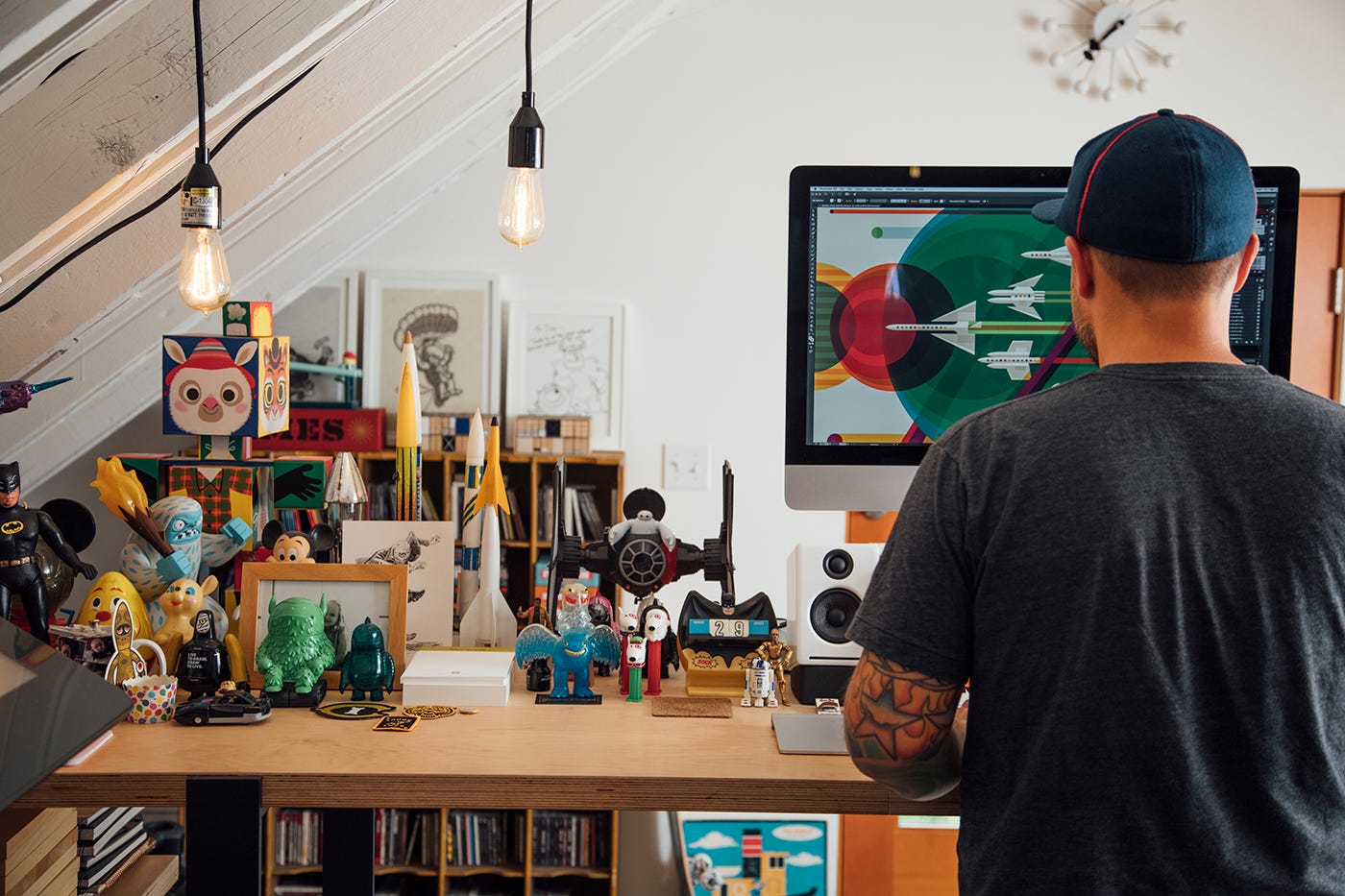
MR: So I don’t want to let this slide: you said you work out every morning.
DC: Yup.
MR: That’s crazy. When did you start doing that?
DC: Probably two and a half years ago, but just as a side note, my wife is now a fitness competitor, so I don’t really have a choice! I’m 44 this month, and that’s a whole other conversation, how mental health and physical health are one and the same. I’m a guy who’s struggled with anxiety and depression, and working out is the prescription.
MR: I wonder if you could draw a line between your creativity in the past two years and working out.
DC: There is a connective line between exercise, creativity, and age. When I was in my 20s and 30s, in my mind I was unstoppable: grinding at work, trying to build this company. I will say it’s gotten harder with age to just not exercise. I’m much more optimistic getting back into the shop if I’ve gone and sweated it out for an hour. Also there’s the camaraderie with the people you exercise with. I work in a barn all day long, so the interaction with other humans is a big deal, too.
MR: Let’s get into the objects in your studio. Can you share one that you think exemplifies your values?
DC: People have asked me, ‘If the barn was on fire, what would you grab?’ And my answer is that I’d just let it burn. Not to get all ecclesiastical, but like, let it burn as long as my family’s safe. Also, what I love is all of my things living in the area together. When you see someone’s insane toy collection you get excited, but if there’s one figure on the shelf you don’t say anything.
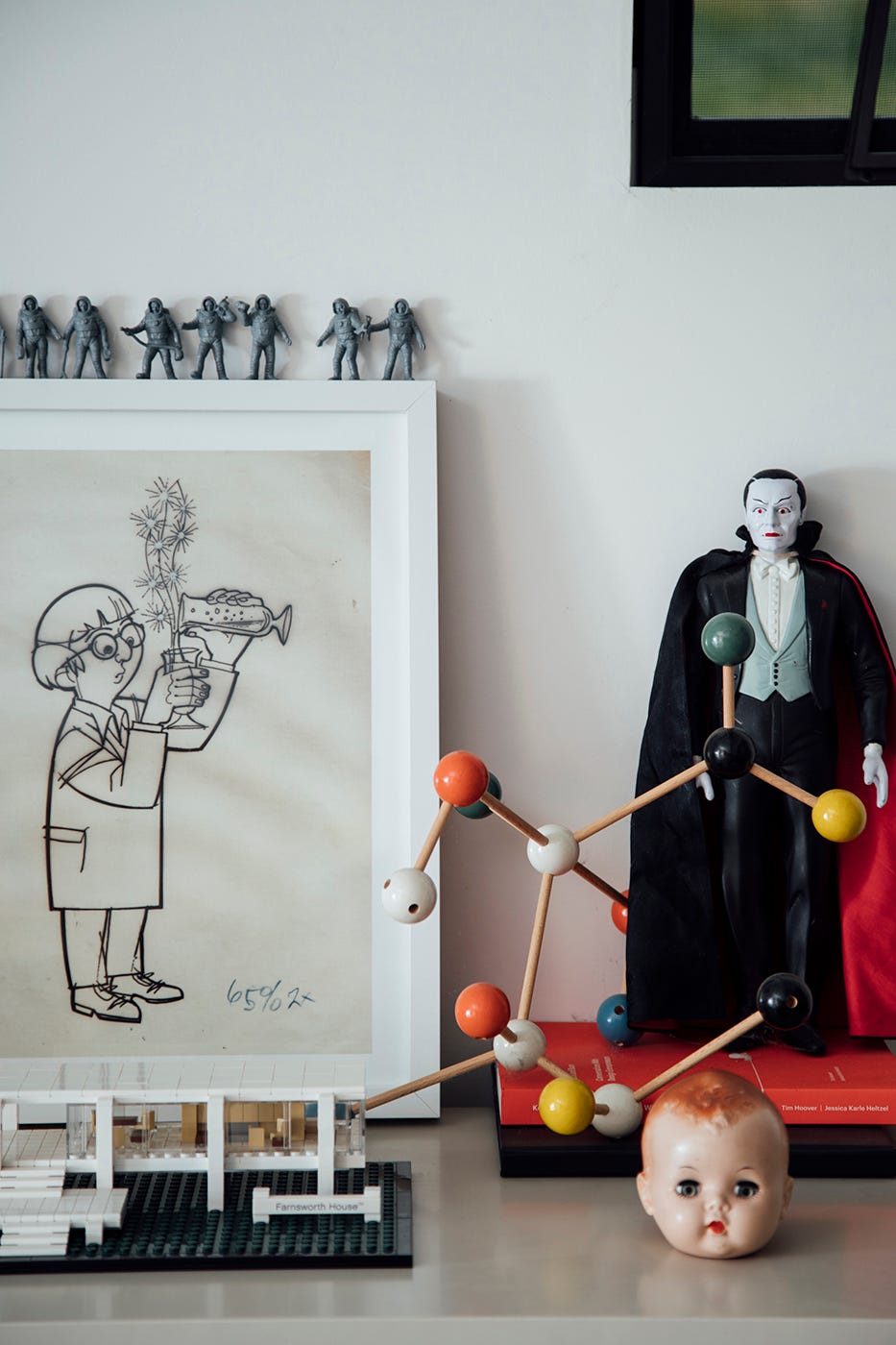
So I don’t know if I have that one thing. It’s probably a piece of art my daughter made or something; all this other stuff is just plastic I bought at a convention center or rummage sale. There’s stuff that sparks joy, like Marie Kondo says…old 50s characters, Star Wars characters. But those things are living out in the open, not in glass cases. People are like, “What about dust?” But that’s part of the charm. I have this cool Eames chair that I bought a long time ago and it’s got scratches all over it from the kids. That thing’s been lived in, and that’s how it should be. Someone once said to me — and it blew my mind — that if you have a problem with your stuff being scratched or used, you have a problem with death. We all end the same way, and you have to come to terms with that. The patina of use and time is a beautiful thing. Especially with kids, your stuff isn’t going to stay nice very long.
MR: It reminds me…the day I brought home my plywood chair, my son sat in it, and he was wearing jeans that have grommets on the pockets —
DC: I know, I have scratches on mine just like that!
MR: I mean, it happened in the first ten minutes. It was extremely painful for me at the time, but it was such a good lesson. You know that’s gonna happen. It’s a chair.
DC: Yeah, it’s a chair, and we’re supposed to sit our asses in it. Also, that mark is from your son. That’s a special thing.
MR: Right. I’m probably going to have that chair for the rest of my life, and when my son moves out — he’s 12 now — I might be looking for that scratch to remind me of him.
DC: Yeah, my son’s 12, too. Exactly.
MR: It sounds like in some regard you don’t ascribe a lot of value to the individual objects that are around you; if anything, you ascribe value to the whole. Or to the atmosphere it creates.
DC: It’s all about what quick little emotion do I get from each thing: “Gosh, that brought back a cool memory,” or “Gosh, that looks good right there.” But it’s gone in a second. If you understand that it’s fleeting you’ll be okay, but if you try to put too much weight on it, you’re going to be let down every time. I definitely put much more importance in objects back in the day, but having a family will change your perspective.
But ultimately, at heart I’m just a big kid. I try to keep everything magical. Of course, we live in a world that can be devastating, so I think the key is to have an understanding of that, too. I do collect toys, I do collect books, and I like to have all these things around me, but I try to keep a healthy grip on reality. As an artist I think it’s easy to be like, “I’m going to create these things that last forever because I’m not going to be here forever,” but the truth of the matter is everyone’s forgotten. Dr. Seuss has a museum, but you walk out of that museum and you forget about him. His family, though: that’s a bigger deal. They shared those little moments with him. There are two aspects to legacy: Legacy with a capital “l” and legacy with a lowercase “l.” I think the capital “l” one is your family.
MR: Really cool, Don. Thanks for sharing all that with us.
DC: I’m honored to. Thank you.
